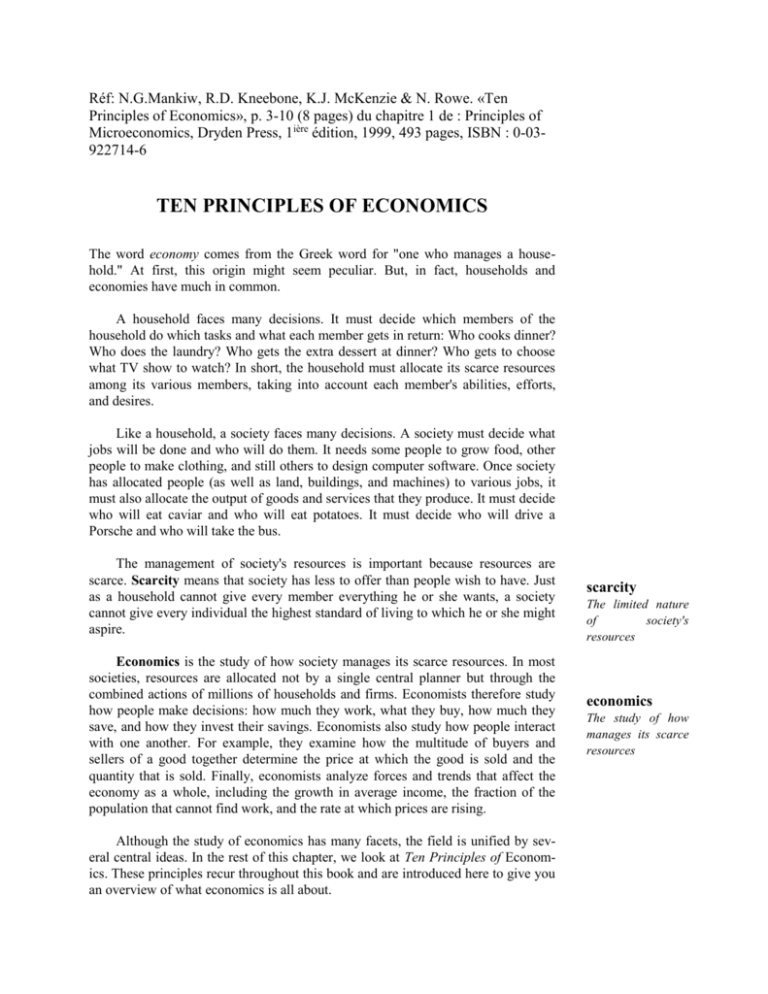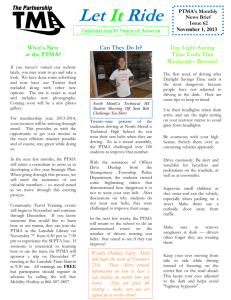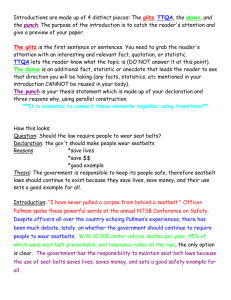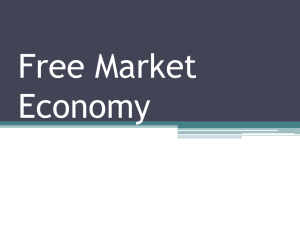Asdf
advertisement

Réf: N.G.Mankiw, R.D. Kneebone, K.J. McKenzie & N. Rowe. «Ten Principles of Economics», p. 3-10 (8 pages) du chapitre 1 de : Principles of Microeconomics, Dryden Press, 1ière édition, 1999, 493 pages, ISBN : 0-03922714-6 TEN PRINCIPLES OF ECONOMICS The word economy comes from the Greek word for "one who manages a household." At first, this origin might seem peculiar. But, in fact, households and economies have much in common. A household faces many decisions. It must decide which members of the household do which tasks and what each member gets in return: Who cooks dinner? Who does the laundry? Who gets the extra dessert at dinner? Who gets to choose what TV show to watch? In short, the household must allocate its scarce resources among its various members, taking into account each member's abilities, efforts, and desires. Like a household, a society faces many decisions. A society must decide what jobs will be done and who will do them. It needs some people to grow food, other people to make clothing, and still others to design computer software. Once society has allocated people (as well as land, buildings, and machines) to various jobs, it must also allocate the output of goods and services that they produce. It must decide who will eat caviar and who will eat potatoes. It must decide who will drive a Porsche and who will take the bus. The management of society's resources is important because resources are scarce. Scarcity means that society has less to offer than people wish to have. Just as a household cannot give every member everything he or she wants, a society cannot give every individual the highest standard of living to which he or she might aspire. Economics is the study of how society manages its scarce resources. In most societies, resources are allocated not by a single central planner but through the combined actions of millions of households and firms. Economists therefore study how people make decisions: how much they work, what they buy, how much they save, and how they invest their savings. Economists also study how people interact with one another. For example, they examine how the multitude of buyers and sellers of a good together determine the price at which the good is sold and the quantity that is sold. Finally, economists analyze forces and trends that affect the economy as a whole, including the growth in average income, the fraction of the population that cannot find work, and the rate at which prices are rising. Although the study of economics has many facets, the field is unified by several central ideas. In the rest of this chapter, we look at Ten Principles of Economics. These principles recur throughout this book and are introduced here to give you an overview of what economics is all about. scarcity The limited nature of society's resources economics The study of how manages its scarce resources HOW PEOPLE MAKE DECISIONS There is no mystery to what an "economy" is. Whether we are talking about the economy of Vancouver, of Canada, or of the whole world, an economy is just a group of people interacting with one another as they go about their lives. Because the behaviour of an economy reflects the behaviour of the individuals who make up the economy, we start our study of economics with four principles of individual decision making. PRINCIPLE #1: People Face Tradeoffs The first lesson about making decisions is summarized in the adage: "There is no such thing as a free lunch." To get one thing that we like, we usually have to give up another thing that we like. Making decisions requires trading off one goal against another. Consider a student who must decide how to allocate her most valuable resource-her time. She can spend all of her time studying economics; she can spend all of her time studying psychology; or she can divide her time between the two fields. For every hour she studies one subject, she gives up an hour she could have used studying the other. And for every hour she spends studying, she gives up an hour that she could have spent napping, bike riding, watching TV, or working at her part-time job for some extra spending money. Or consider parents deciding how to spend their family income. They can buy food, clothing, or a family vacation. Or they can save some of the family income for retirement or the children's university education. When they choose to spend an extra dollar on one of these goods, they have one less dollar to spend on some other good. When people are grouped into societies, they face different kinds of tradeoffs. The classic tradeoff is between "guns and butter." The more we spend on national defence to protect our shores from foreign aggressors (guns), the less we can spend on personal goods to raise our standard of living at home (butter). Also important in modern society is the tradeoff between a clean environment and a high level of income. Laws that require firms to reduce pollution raise the cost of producing goods and services. Because of the higher costs, these firms end up earning smaller profits, paying lower wages, charging higher prices, or some combination of these three. Thus, while pollution regulations give us the benefit of a cleaner environment and the improved health that comes with it, they have the cost of reducing the incomes of the firms' owners, workers, and customers. Another tradeoff society faces is between efficiency and equity. Efficiency means that society is getting the most it can from its scarce resources. Equity means that the benefits of those resources are distributed fairly among society's members. In other words, efficiency refers to the size of the economic pie, and equity refers to how the pie is divided. Often, when government policies are being designed, these two goals conflict. efficiency The property of society getting the most it can from its scarce resources equity The property of distributing economic prosperity fairly among the members of society Consider, for example, policies aimed at achieving a more equal distribution of economic well-being. Some of these policies, such as the welfare system or employment insurance, try to help those members of society who are most in need. Others, such as the individual income tax, ask the financially successful to contribute more than others to support the government Although these policies have the benefit of achieving greater equity, they have a cost in terms of reduced efficiency. When the government redistributes income from the rich to the poor, it reduces the reward for working hard; as a result, people work less and produce fewer goods and services. In other words, when the government tries to cut the economic pie into more equal slices, the pie gets smaller. Recognizing that people face tradeoffs does not by itself tell us what decisions they will or should make. A student should not abandon the study of psychology just because doing so would increase the time available for the study of economics. Society should not stop protecting the environment just because environmental regulations reduce our material standard of living. The poor should not be ignored just because helping them distorts work incentives. Nonetheless, acknowledging life's tradeoffs is important because people are likely to make good decisions only if they understand the options that they have available. PRINCIPLE #2: The Cost of Something Is What You Give Up to Get It Because people face tradeoffs, making decisions requires comparing the costs and benefits of alternative courses of action. In many cases, however, the cost of some action is not as obvious as it might first appear. Consider, for example, the decision whether to go to university. The benefit is intellectual enrichment and a lifetime of better job opportunities. But what is the cost? To answer this question, you might be tempted to add up the money you spend on tuition, books, room, and board. Yet this total does not truly represent what you give up to spend a year in university. The first problem with this answer is that it includes some things that are not really costs of going to university Even if you quit school, you would need a place to sleep and food to eat. Room and board are costs of going to university only to the extent that they are more expensive at university than elsewhere. Indeed, the cost of room and board at your school might be less than the rent and food expenses that you would pay living on your own. In this case, the savings on room and board are a benefit of going to university. The second problem with this calculation of costs is that it ignores the largest cost of going to university-your time. When you Spend a year listening to lectures, reading textbooks, and writing essays, you cannot spend that time working at a job. For most students, the wages given up to attend school are the largest single cost of their education. The opportunity cost of an item is what you give up to get that Item. When making any decision, such as whether to attend university, decision-makers should be aware of the opportunity costs that accompany each possible action. In fact, they usually are. University-age athletes who can earn millions if they drop out of school and play professional sports are well aware that their opportunity cost of university is very high. It is not surprising that they often decide that the benefit is not worth the cost. opportunity cost Whatever must be given up to obtain some item PRINCIPLE #3: Rational People Think at the Margin Many decisions in life involve making small incremental adjustments to an existing plan of action. Economists call these marginal changes. In many situations, people will make the best decisions by thinking at the margin. Suppose, for example, that a friend asks your advice about how many years to stay in school. if you were to compare for him the lifestyle of a person with a Ph.D. to that of a high-school drop-out, he might complain that this comparison is not helpful for his decision. Your friend is more likely to have some education already and to be deciding whether to spend an extra year or two in school. To make this decision, he needs to know the additional benefits that an extra year in school would offer and the additional costs that he would incur. By comparing these marginal benefits and marginal costs, he can evaluate whether the extra year is worthwhile. As another example of how thinking at the margin helps decision making, consider an airline deciding how much to charge passengers who fly standby. Suppose that flying a 200 seat plane across the country costs the airline $100000. In this case, the average cost of each seat is $100000 / 200, which is $500. One might be tempted to conclude that the airline should never sell a ticket for less than $500. Yet the airline can raise its profits by thinking at the margin. Suppose that a plane is about to take off with ten empty seats. A standby passenger is waiting at the gate willing to pay $300 for a seat. Should the airline sell it to him? Of course it should. If the plane has empty seats, the cost of adding one more passenger is minuscule. Although the average cost of flying a passenger is $500, the margin cost is merely the cost of the bag of peanuts and can of soda that the extra passenger will consume. As long as the standby passenger pays more than the marginal cost, selling him a ticket is profitable. As these examples show, individuals and firms can make better decisions by thinking at the margin. A rational decision-maker takes an action if and only if the marginal benefit of the action exceeds the marginal cost. PRINCIPLE #4: People Respond to Incentives Because people make decisions by comparing costs and benefits, their behaviour may change when the costs or benefits change. That is, people respond to incentives. When the price of an apple rises, for example, people decide to eat more pears and fewer apples, because the cost of buying an apple is higher. At the same time, apple orchards decide to hire more workers and harvest more apples, because the benefit of selling an apple is also higher. The central role of incentives in determining behaviour is important for those marginal changes Small incremental adjustments to a plan of action designing public policy. Public policies often alter the costs or benefits of private actions. When policy-makers fail to consider how behaviour might change as a result, their policies can have effects that they did not intend. As an example of such unintended effects, consider public policy toward seat belts and auto safety. In the 1950s few cars had seat belts. Today all cars do, and the reason for the change is public policy. In the late 1960's, Ralph Nader's book Unsafe at Any Speed generated much public concern over auto safety. Governments responded with legislation requiring car companies to make various safety features, including seat belts, standard equipment on all new cars. How does a seat belt law affect auto safety? The direct effect is obvious. With seat belts in all cars, more people wear seat belts, and the probability of surviving a major auto accident rises. In this sense, seat belts save lives. This direct impact of seat belts on safety is what motivated governments to require seat belts. Yet, to understand fully the effects of this law, one must recognize that people change their behaviour in response to the incentives they face. In this case, the relevant behaviour is the speed and care with which drivers operate their automobiles. Driving slowly and carefully is costly because it uses the driver's time and energy. When deciding how safely to drive, rational people compare the marginal benefit from safer driving to the marginal cost. They drive more slowly and carefully when the benefit of increased safety is high. This explains why people drive more slowly and carefully when roads are icy than when roads are dear. Now consider how a seat belt law alters the cost-benefit calculation of a rational driver. Seat belts make accidents less costly for a driver because they reduce the probability of injury or death. Thus, a seat belt law reduces the benefits to slow and careful driving. People respond to seat belts as they would to an improvement in road conditions-by faster and less careful driving. The end result of a seat belt law, therefore, is a larger number of accidents. How does the law affect the number of deaths from driving? Drivers who wear their seat belts are more likely to survive any given accident, but they are more likely to find themselves in an accident. The net effect is ambiguous. More-over, the reduction in safe driving has a dear adverse impact on pedestrians (and on drivers who do not wear their seat belts). They are put in jeopardy by the law because they are more likely to find themselves in an accident but are not protected by a seat belt. Thus, a seat belt law tends to increase the number of pedestrian deaths. At first, this discussion of incentives and seat belts might seem like idle speculation. Yet, in an article published in 1975, economist Sam Peltzman showed that the auto safety laws have, in fact, had many of these effects. According to Peltzman's evidence, these laws produce both fewer deaths per accident and more accidents. The net result is little change in the number of driver deaths and an increase in the number of pedestrian deaths. Peltzman's analysis of auto safety is just one example of the general principle that people respond to incentives. Many of the incentives that economists study are more straightforward than those of the auto safety laws. For example, no one is surprised that a tax on apples causes people to buy fewer apples. Yet, as the seat belt example shows, policies sometimes have effects that are not obvious in advance. In analyzing any policy, one must consider not only the direct effects but also the indirect effects that work through incentives. If the policy changes incentives, it will cause people to alter their behaviour. QUICK QUIZ List and briefly explain the four principles of individual decision making. HOW PEOPLE INTERACT The first four principles discussed how individuals make decisions. As we go about our lives, many of our decisions affect not only ourselves but other people as well. The next three principles concern how people interact with one another. PRINCIPLE #5: Trade Can Make Everyone Better Off You have probably heard on the news that the Americans are our competitors in the world economy. In some ways, this is true, for Canadian and American firms do produce many of the same goods. Northern Telecom and General Electric compete for the same customers in the market for telephones. Brights and Gallo compete for the same customers in the market for wine. Yet it is easy to be misled when thinking about competition among countries. Trade between Canada and the United States is not like a sports contest, where one side wins and the other side loses. In fact, the opposite is true: Trade between two countries can make each country better off. To see why, consider how trade affects your family. When a member of your family looks for a job, he or she competes against members of other families who are looking for jobs. Families also compete against one another when they go shopping, because each family wants to buy the best goods at the lowest prices. So, in a sense, each family in the economy is competing with all other families. Despite this competition, your family would not be better off isolating itself from all other families. If it did, your family would need to grow its own food, make its own clothes, and build its own home. Clearly, your family gains much from its ability to trade with others. Trade allows each person to specialize in the activities he or she does best, whether it is farming, sewing, or home building. By trading with others, people can buy a greater variety of goods and services at lower cost. Countries as well as families benefit from the ability to trade with one another. Trade allows countries to specialize in what they do best and to enjoy a greater variety of goods and services. The Americans, as well as the Japanese and the Chileans and the Mexicans, are as much our partners in the world economy as they ate our competitors. PRINCIPLE #6: Markets Ave Usually a Good Way to Organize Economic Activity The collapse of communism in the Soviet Union and Eastern Europe may be the most important change in the world during the past half century. Communist countries worked on the premise that central planners in the government were in the best position to guide economic activity. These planners decided what goods and services were produced, how much was produced, and who produced and consumed these goods and services. The theory behind central planning was that only the government could organize economic activity in a way that promoted economic well-being for the country as a whole. Today, most countries that once had centrally planned economies have abandoned this system and are trying to develop market economies. In a market economy, the decisions of a central planner are replaced by the decisions of millions of firms and households. Firms decide whom to hire and what to make. Households decide which firms to work for and what to buy with their incomes. These firms and households interact in the marketplace, where prices and selfinterest guide their decisions. At first glance, the success of market economies is puzzling. It might seem as if decentralized decision making by millions of self-interested households and firms would result in chaos. Yet this is not the case. Market economies have proven remarkably successful in organizing economic activity in a way that promotes general economic well-being. In his 1776 book The Wealth of Nations, economist Adam Smith made the most famous observation in all of economics: Households and firms interacting in markets act as if they are guided by an "invisible hand" that leads them to desirable market outcomes. One of our goals in this book is to understand how this invisible hand works its magic. As you study economics, you will learn that prices are the instrument with which the invisible hand directs economic activity. Prices reflect both the value of a good to society and the cost to society of making the good. Because households and firms look at prices when deciding what to buy and sell, they unknowingly take into account the social benefits and costs of their actions. As a result, prices guide these individual decision-makers to reach outcomes that, in many cases, maximise the welfare of society as a whole. There is an important corollary to the skill of the invisible hand in guiding economic activity: When the government prevents prices from adjusting naturally to supply and demand, it impedes the invisible hand's ability to co-ordinate the millions of households and firms that make up the economy. This corollary explains why taxes adversely affect the allocation of resources: Taxes distort prices and thus the decisions of households and firms. It also explains the even greater harm caused by policies that directly control prices, such as rent control. And it explains the failure of communism. In communist countries, prices were not determined in the marketplace but were dictated by central planners. These planners lacked the information that gets reflected in prices when prices are free to respond to market forces. Central planners failed because they tried to run the economy with one hand market economy an economy that allocates resources through the decentralized decisions of many firms and household as they interact in markets for goods and services tied behind their backs-the invisible hand of the marketplace. PRINCIPLE #7: Governments Can Sometimes Improve Market Outcomes Although markets are usually a good way to organize economic activity, this rule has some important exceptions. There are two broad reasons for a government to intervene in the economy: to promote efficiency and to promote equity. That is, most policies aim either to enlarge the economic pie or to change how the pie is divided. The invisible hand usually leads markets to allocate resources efficiently. Nonetheless, for various lessons, the invisible hand sometimes does not work. Economists use the term market failure to refer to a situation in which the market on its own falls to allocate resources efficiently. One possible cause of market failure is an externality. An externality is the impact of one parson's actions on the well-being of a bystander. Pollution is the classic example. If a chemical factory does not bear the entire cost of the smoke it emits, it will likely emit too much. In this case, the government can raise economic well-being through environmental regulation. Another possible cause of market failure is market power. Market power refers to the ability of a single person (or small group of people) to unduly influence market prices. For example, suppose that everyone in town needs water but there is only one well. The owner of the well has market power-in this case a monopoly - the sale of water. The well owner is not subject to the rigorous competition with which the invisible hand normally keeps Self-interest in check. You will learn that, in this case, regulating the price that the monopolist charges can potentially enhance economic efficiency. The invisible hand is even less able to ensure that economic prosperity is distributed fairly. A market economy rewards people according to their ability to produce things that other people are willing to pay for. The world's best hockey player earns more than the world's best chess player simply because people are willing to pay more to see hockey than chess. The invisible hand does not ensure that everyone has sufficient food, decent clothing, and adequate health care. A goal of many public policies, such as the income tax and the welfare system, is to achieve a more equitable distribution of economic well-being. To say that the government can improve on market outcomes at times does not mean that it always will. Public policy is made not by angel but by a political process that is far from perfect. Sometimes policies are designed simply to reward the politically powerful. Sometimes they are made by wellintentioned leaders who are not fully informed. One goal of the study of economics is to help you judge when a government policy is justifiable to promote efficiency or equity and when it is not. market failure A situation in which a market left on its own fails to allocate resources efficiently externality The impact of one person's actions on the well-being of a bystander market power The ability of a single economic actor (or small group of factors) to have a substantial influence on market prices QUICK QUIZ List and briefly explain the three principles concerning economic interactions.






